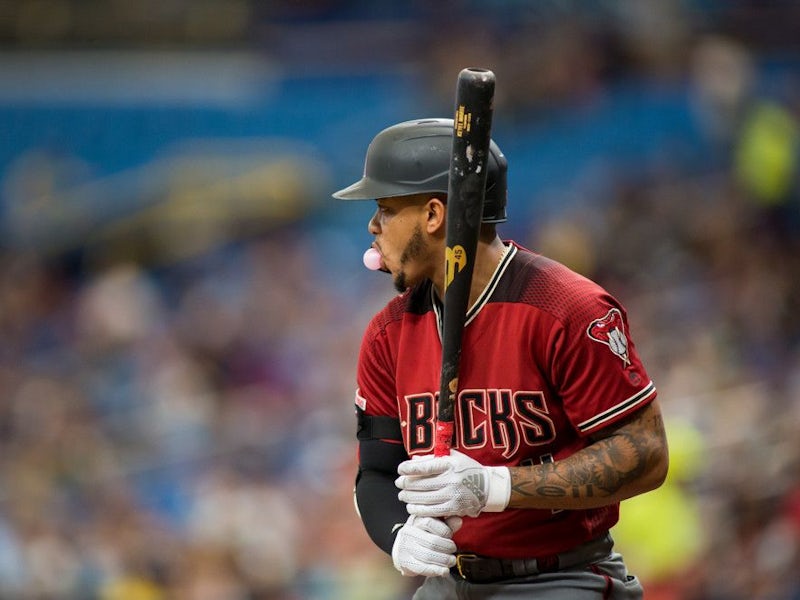ADVERTISEMENT
Criscola: How I'd fix baseball

MLB Opening Day ceremonies at Nationals Park. (Photo by Tony Quinn/Icon Sportswire)
I’ve been in love with baseball for as long as I can remember, but people like me are disappearing.
The MLB is losing fans in droves; from 2015 to 2019, the total attendance at baseball games plummeted from 73.7 million to 68.5 million. The 2020 World Series was the least-watched in history by a factor of nearly three million fans.
I’m gonna go get the papers, get the papers: back page edition. Always @Mets-ing about … pic.twitter.com/RPp0JqFwnD
— Robert Shields (@rshields37) August 30, 2021
I grew up a New York Mets fan, so I know a mess when I see one. I’ll wade through some of the most recent rule changes implemented by MLB commissioner Rob Manfred, and some of the proposed ones that haven’t made it to the majors yet, in an attempt to “fix” our nation’s pastime.
Install a pitch clock
Since Manfred took over as commissioner in 2015, the average length of a nine-inning MLB game has jumped from two hours and 56 minutes to three hours and nine minutes. This is the continuation of an alarming trend for baseball.
In 1911, the average length of an MLB game was a crisp one hour and 45 minutes. By 1951, it was two hours and 19 minutes. In 1981 it was still a reasonable two hours and 33 minutes, but by 1991 it was a bloated two hours and 48 minutes, and it’s only getting worse.
Buck Showalter nails it here about baseball needing to speed up the game and implement a pitch clock. pic.twitter.com/IAEp87kyty
— Gershon Rabinowitz (@GershOnline) December 18, 2020
There are numerous reasons why the average game is taking longer than ever, chief among them being the rate at which relief pitchers are deployed. The three-batter minimum – introduced in 2020 – hasn’t helped save much time, and has only irked veteran MLB managers like Joe Girardi, who called it “the dumbest rule that we’ve ever put in.”
By installing a 20-second pitch clock, which has been used in the minor leagues since 2015, the average length of an MLB game could be reduced by at least several minutes. In the interest of fairness to pitchers, batters should also be barred from stepping out of the box during an at-bat for no good reason, and be restricted to one "time out" per appearance.
Move the pitching rubber back by one foot
Strikeouts are rising with every given year, and baseball is just beginning to do something about it. A mid-season crackdown on pitchers using “sticky stuff” to manipulate baseballs may not have been the right way to go about things, but it has yielded fewer strikeouts.
Sergio Romo was animated after umpires asked to check him for sticky stuff. pic.twitter.com/vJM0tJ5rVa
— SportsCenter (@SportsCenter) June 23, 2021
However, the sticky stuff crackdown is not enough. Increased velocity is also frequently cited as one of the primary causes of the uptick in strikeouts. Moving the pitching rubber back, which the minor leagues are just beginning to experiment with, could reduce velocity significantly enough and give historically-anemic offenses a shot in the arm.
Abolish the extra-inning “ghost runner,” seven-inning doubleheaders
Two of the rules introduced in 2020 to speed up games that were unfortunately kept in 2021 need to disappear.
The inherited runner at second base to begin each extra inning has shortened games, but has also cheapened the product. Seven-inning doubleheaders have also served to denigrate the game, as fans are now being charged nine-inning prices for seven-inning contests.
Eradicating both rules posthaste will help preserve the integrity of baseball.
Restrict infield shifts
Infield shifts were a fairly rare occurrence in baseball until just a few years ago, but now shifts are deployed twice an inning on average. Shifts even move during changes in the count against a batter, as teams feel they are gaining an advantage based on deep analytics. It’s time for this comical game of infield musical chairs to go.
a runner going first to home on an infield single is a truly hilarious backfiring outcome for the infield shift https://t.co/KEcK56h0UP
— Joon 이준엽 (@joonlee) May 6, 2021
Baseball should mandate, as they already have in the Atlantic League, that two infielders be lined up in the dirt on one side of second base, and two on the other. Outfielders must also remain positioned in the outfield grass, and not serve as a de facto fifth infielder.
Eliminate warm-up throws from the mound for relief pitchers
It’s completely nonsensical that relief pitchers are allowed to throw as many warm-up pitches as they want in the bullpen, and then when they’re brought into the game, they’re allowed to throw more from the mound.
Those extra warm-up pitches add an unnecessary two-minute commercial break every time a reliever is brought in during the progression of an inning. This accommodation that’s been taken for granted for many years should be wiped away in the interest of shedding some “dead time” from MLB games.
The only exception would apply to relievers that are brought in “cold” from the bullpen due to an injury to the previous pitcher.
ADVERTISEMENT


